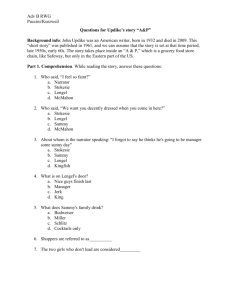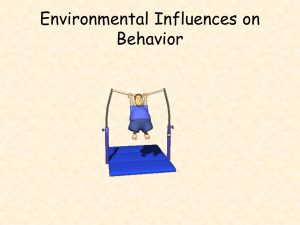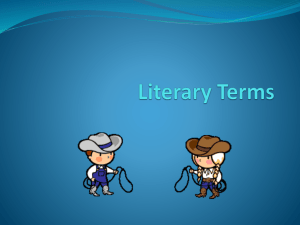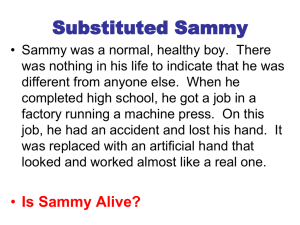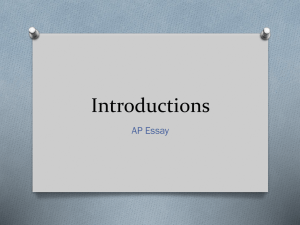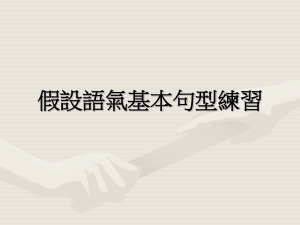Analyzing to Draw Conclusions & using MLA for Sources
advertisement
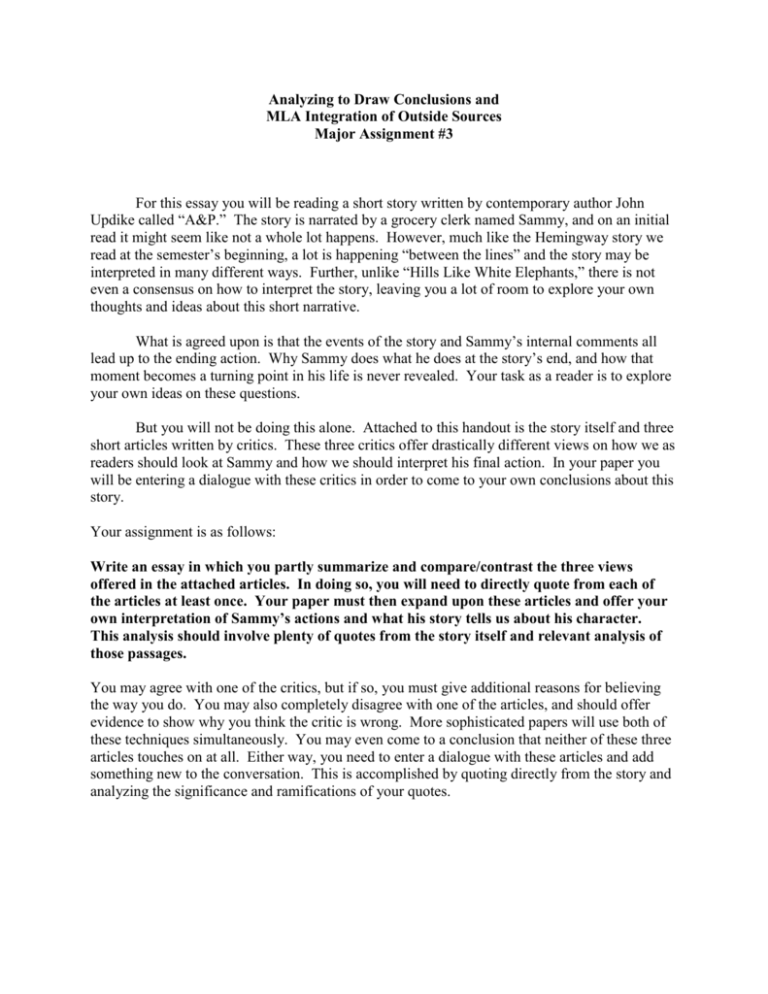
Analyzing to Draw Conclusions and MLA Integration of Outside Sources Major Assignment #3 For this essay you will be reading a short story written by contemporary author John Updike called “A&P.” The story is narrated by a grocery clerk named Sammy, and on an initial read it might seem like not a whole lot happens. However, much like the Hemingway story we read at the semester’s beginning, a lot is happening “between the lines” and the story may be interpreted in many different ways. Further, unlike “Hills Like White Elephants,” there is not even a consensus on how to interpret the story, leaving you a lot of room to explore your own thoughts and ideas about this short narrative. What is agreed upon is that the events of the story and Sammy’s internal comments all lead up to the ending action. Why Sammy does what he does at the story’s end, and how that moment becomes a turning point in his life is never revealed. Your task as a reader is to explore your own ideas on these questions. But you will not be doing this alone. Attached to this handout is the story itself and three short articles written by critics. These three critics offer drastically different views on how we as readers should look at Sammy and how we should interpret his final action. In your paper you will be entering a dialogue with these critics in order to come to your own conclusions about this story. Your assignment is as follows: Write an essay in which you partly summarize and compare/contrast the three views offered in the attached articles. In doing so, you will need to directly quote from each of the articles at least once. Your paper must then expand upon these articles and offer your own interpretation of Sammy’s actions and what his story tells us about his character. This analysis should involve plenty of quotes from the story itself and relevant analysis of those passages. You may agree with one of the critics, but if so, you must give additional reasons for believing the way you do. You may also completely disagree with one of the articles, and should offer evidence to show why you think the critic is wrong. More sophisticated papers will use both of these techniques simultaneously. You may even come to a conclusion that neither of these three articles touches on at all. Either way, you need to enter a dialogue with these articles and add something new to the conversation. This is accomplished by quoting directly from the story and analyzing the significance and ramifications of your quotes. Things you may want to consider while making your argument: Sammy’s word choices Sammy’s age—which may not be exactly stated, you may have to speculate The metaphors Sammy uses to describe people Significance of Sammy working in and the story taking place in a grocery store The time period of this story—it takes place in the 1950’s. anything else that strikes you as relevant as long as you are analyzing If you think you have nothing new to say about this story, remember you have something that neither of these three critics do. You’ve been in a class for eight weeks now that has talked about consumerism and the mindset of teenage boys. You may find some freewriting will connect this story to these articles quite nicely. This essay should be 6-8 pages, not including the Works Cited page. Refer to syllabus for proper formatting of the essay, and refer to your MLA handout and class notes for proper citation methods. Improper methods of MLA citation will affect the paper’s final grade. November 8th is the due date for the first draft. Bring three copies for peer edit. November 12th is the due date of the second draft to be turned into me. November 19th is the due date for the final draft. John Updike's "A & P" Commentary by Karen Bernardo Updike’s "A & P" tells the story of a checkout boy, Sammy, who quits his job after his boss Mr. Lengel speaks disparagingly to three teenage girls who come into the grocery store on a summer afternoon. But on a deeper level, the story is a contrast of worldviews: the conservative, conventional, and stoic (represented by Mr. Lengel) against the free-spirited, individualistic, and non-conformist (represented by the teenage girls). Even though Lengel does not make his physical appearance until near the story’s end, his arrival has in a way been foreshadowed by a number of other characters who preceded him. For example, Updike notes that as soon as the three girls appear in the A & P, the "sheep" -Sammy’s word for the run-of-the-mill customers who plod through the store, pushing their shopping carts, following their prescribed routes -- react to their presence with amazement; "You could see them, when Queenie’s white shoulders dawned on them, kind of jerk, or hop, or hiccup, but their eyes snapped back to their own baskets and on they pushed." The staff of the market, likewise, can hardly believe it when these three girls traipse in. Stokesie, another young clerk, who is married and the father of two babies, comments to Sammy that the girls make him "feel so faint." An older clerk, McMahon, begins "patting his mouth and looking after them, sizing up their joints." What all of these men are reacting to, clearly, is the presence of sex, raw sex, in an environment which is usually free of it. After the three girls have paraded through the store for three full pages, Mr. Lengel the manager comes on the scene. Sammy tells us that his boss "comes in from struggling with a truck full of cabbages" when "the girls touch his eye." Our very first view of Mr. Lengel, therefore, shows him engaged in hard, manual labor as opposed to the frivolous activity of the girls. Lengel’s remark to the girls -- "This isn’t the beach" -- reinforces this. Sammy observes that the way Lengel insistently repeats this remark seems "as if it had occurred to him, and he had been thinking all these years the A & P was a big sand dune and he was the head lifeguard." Which, in a very profound way, he is: as not only the manager of the A & P but a Sunday School teacher, he feels he has the right to set the tone for what is considered acceptable in his arena. But his "sand dune" is the world of work, whereas the girls’ is the world of play. He therefore approaches the girls and scolds them, implying that their attire has violated and desecrated his space. Note that his obvious displeasure at the girls’ appearance does not stop him from telling Sammy to ring up their purchase and take their money so they can leave. But this is too much for Sammy. He mumbles under his breath that he quits, and when Mr. Lengel asks him to repeat his last remark, Sammy complies -- pulling off his apron and walking out. Mr. Lengel warns him that "You’ll feel this for the rest of your life," and Updike writes that Sammy "know[s] that’s true." What precisely has just happened? Why did Sammy quit? He tells Mr. Lengel that "You didn’t have to embarrass them," to which Mr. Lengel replies, "It was they who were embarrassing us." Since Sammy is clearly not embarrassed, the "us" refers not to Sammy but to Mr. Lengel and the entire town his attitude represents. Sammy is therefore telling Mr. Lengel that in his own belief system, people should be able to be frivolous when they want to. They should be able to come into a store in bathing suits to buy snacks, and they should be able to turn heads when they do it. Young men should be able to be attracted to young women without feeling guilty, and when they do, society should be able to withstand the shock. To confine oneself to Mr. Lengel’s view of society is to condemn oneself to the ordinary. In the last sentence of the story, Sammy realizes, as he walks away from the store, "how hard the world was going to be to me hereafter" -- but it will only be hard in the sense that Sammy will forever be forced to buck the Lengels of the world, who will outnumber him a thousand to one. Sammy at least has given himself a shot at achieving real joy in his life; Mr. Lengel will never even know that joy exists, because his worldview is too narrow to admit it. http://www.storybites.com/updikeaandp.htm An Analysis of "A&P," a story by John Updike English Composition 101 N. Montague In his short story "A & P" John Updike utilizes a 19-year-old adolescent to show us how a boy gets one step closer to adulthood. Sammy, an A & P checkout clerk, talks to the reader with blunt first person observations setting the tone of the story from the outset. The setting of the story shows us Sammy's position in life and where he really wants to be. Through the characterization of Sammy, Updike employs a simple heroic gesture to teach us that actions have consequences and we are responsible for our own actions. Sammy is a 19-year-old boy conveying a cocky but cute male attitude. He describes three girls entering the A & P, setting the tone of the story. "In walk these three girls in nothing but bathing suits. There was this chunky one, with the two piece-it was bright green and the seams on the bra were still sharp and her belly was still pretty pale...there was this one, with one of those chubby berry-faces, the lips all bunched together under her nose, this one, and a tall one, with black hair that hadn't quite frizzed right...you know the kind of girl other girls think is very "striking" and "attractive" but never quite makes it' ... She was the queen with "long white prima-donna legs." Completely distracted by the girls, Sammy rings a box of HiHo crackers twice, infuriating the customer. He describes her as being " One of these cash-register-watchers, a witch of about fifty with rouge on her cheekbones and no eyebrows, and I know it made her day to trip me up," sarcastically conveying his chauvinistic attitude toward women. We learn about Sammy's station in life through the setting of the story. He is not a big time war hero or superstar but a checker at a small town A & P, not moving up in his job or down, simply stagnant. The town is located north of Boston, five miles from a beach, with a summer colony on the Point. Sammy is ready to make a change. He wants to be part of the girls' world. Sammy's thoughts give us some insight in his feeling that the girls, just like the wealthy summer colony they came from, are out of his reach. "All of a sudden I slid right down her voice into her living room. Her father and all the other men were standing around in ice-cream coats and bow ties...When my parents have somebody over they get lemonade and if it's a real racy affair Schlitz in tall glasses with 'They'll Do It Every time' cartoons stenciled on." The girls are buying a jar of Kingfish Fancy Herring Snacks as Lengel, thc store manager and Sunday school teacher, criticizes their dress, "Girls this isn't the beach." The queen answers, "My mother asked me to pick up a jar of herring snacks." Lengel continues to harass the girls. "Girls, I don't want to argue with you. After this come in here with your shoulders covered. It's our policy." Sammy , having had enough of Lengel embarrassing the girls, now takes what he considers heroic action announcing, "I quit." Taking off his apron and bow tie, Sammly leaves thc store with a final ring of "NO SALE." He is hoping the girls will give some sign of recognition to his heroic act on their behalf, yet they do not. One critic describes Sammy's quitting as "the reflex of the still uncorrupted, of the youth still capable of the grand gesture because he has not learned the sad wisdom of compromise"(Uphaus 127). Updike successfully shows that our actions have consequences through Sammy who was trying to take a stand on a small but heroic principle. He is ignored by the wealthy girls. He does not have ajob. "With a single act he achieves a new integrity, one that divorces him from his unthinking conservative environment and leaves him, not with a suddenly developed affinity to the wealthy set, but with a loneliness that signals his birth into alienation"(Detweiler 68). Sammy looks for the girls who have gone. He sees a young married woman, yelling at her children and realizes, "How the world was going to be to me here after." http://www.stlcc.cc.mo.us/mc/support/cwc/fpages/lit2.html Updike's A&P The Explicator; Washington; Summer 2001; Corey Evan Thompson 59 4 215-216 00144940 Short stories Literary criticism Personal Names: Updike, John Abstract: Volume: Issue: Start Page: ISSN: Subject Terms: Thompson discusses John Updike's short story "A & P," which chronicles Sammy, the protagonist's, seemingly impulsive decision to quit his dead-end job at a local supermarket. Sammy should not be regarded as a hero, but rather as a frustrated young man who takes full advantage of an opportunity to free himself from the responsibility-filled life that he desperately wants to avoid. Full Text: Copyright HELDREF PUBLICATIONS Summer 2001 John Updike's most anthologized short story, "A & P," chronicles the protagonist's seemingly impulsive decision to quit his job at the local supermarket. On the basis of Sammy's forceful stand against his boss Mr. Lengel, who nearly kicks three girls out of the A & P for failing to comply with the "no shirt, no shoes, no service" rule, the established critical stance has placed Sammy in the position of "hero" (Saldivar 215-16). Although classifying Sammy as a hero is understandable, since he views himself as one (Updike 195), critics have failed to adequately consider the fact that he is also the narrator through whose limited point of view the story is told. Thus, he reveals much about the impetus behind his resignation when he describes the events prompting his decision to quit. In "John Updike's 'A & P': A Return Visit to Araby," Walter Wells correctly recognizes that Sammy is frustrated. But the source of Sammy's frustration eludes Wells; he attributes it to Sammy's "infatuation with a beautiful but inaccessible girl" (128). The text suggests, however, that Sammy is not frustrated because he cannot woo Queenie but because of the length of time he has been working at the supermarket and his daily encounters with customers. Sammy wishes to quit, but he resists doing so because his parents would regard his decision as "the sad part of the story" (192). Sammy must, therefore, remain an employee until he can find a reason to justify his quitting. Though masking his actions as chivalry, Sammy uses the girls; for they act as catalysts that precipitate his well-considered decision to resign. Sammy observes the girls walking "up the cat-and-dog-food-breakfastcereal-macaroni-riceraisins-seasonings-spreads-spaghetti-soft-drinks-crackers-and-cookies aisle" (189-90). He gives a detailed description of the supermarket's floor and knows of every event that occurs outside the store's front window (190-91). Clearly Sammy has been working at the A & P for a very long time. Sammy routinely deals with customers for whom he has no respect, describing them as "witch[es]," "bums," and "sheep" (187, 192, 194): "I stood there with my hand on a box of HiHo crackers trying to remember if I rang it up or not. I ring it up again and the customer starts giving me hell. She's one of these cash-register watchers, a witch about fifty" (187). He suggests that he has been thinking about quitting for at least a few months because he recognizes the advantages of doing so in the summer rather than the winter (196). As the girls enter the store, Sammy solely views them as sex objects. He goes from noticing how little the girls are wearing, to what they are not wearing, to finally focusing on their bare skin. He initially notices that they are wearing "nothing but bathing suits" (187) then that "[t]hey didn't even have shoes on" (188). Sammy moves from clothing to skin in his third observation: "She held her head so high her neck, coming up out of those white shoulders, looked kind of stretched, but I didn't mind. The longer her neck was, the more of her there was" (189). By privileging the girls' skin over their clothing, Sammy indicates that his main interest lies in their bodies and not in their right to wear bathing suits in the supermarket. He describes their bodies in terms of common items found in the supermarket; by drawing a parallel between the store's commodities and the girls, Sammy suggests that they, like the commodities, are merely objects to be observed, handled, and used. He describes one girl as having "a soft looking can with those two crescents of white just under it" (187), and the other as having "one of those chubby berry faces" (188). Most significantly, he views Queenie's breasts as "the two smoothest scoops of vanilla [he] had ever known" (195). Once the disagreement between Lengel and the girls commences, Sammy begins to spend "all [his] time thinking" (195). Presumably he has begun to realize that the incident offers him the perfect opportunity to free himself from his dead-end job. Sammy should not be regarded as a hero, but rather as a young man who takes full advantage of an opportunity to free himself from the responsibility-filled life that he desperately wants to avoid.
